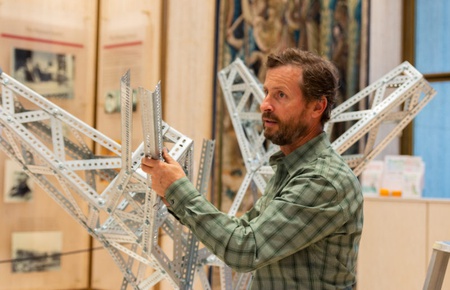Voice of San Diego by Sara Libby
San Diego sculptor Roman de Salvo, the newest artist-in-residence at the Timken Museum, recently began building the equivalent of a large-scale erector set inside the Balboa Park museum’s atrium. At first glance, it seems like a project founded in engineering or physics, but de Salvo’s method started with biology, particularly bifurcation.
Bifurcation, or branching into two segments, is found in trees, plants, human biology and countless other dichotomies or divisions in the natural world.
Technically, though, de Salvo started with art: The Timken’s summer residency program, now in its second year, asks its residents to produce a work inspired by a piece of art in the museum’s permanent collection.
The Timken, Balboa Park’s only admission-free institution, opened in 1965 with a small but impressive collection of European old master works. It doesn’t often exhibit contemporary works, and its new residency program seeks to change that. Last summer, Bhavna Mehta created a large-scale installation [1] based on Veneto’s “Portrait of a Lady.” These residencies are a way for the Timken to meld its historic collection with new, architecturally minded works by living artists.
The Art (and Science) of Bifurcation
De Salvo chose a Rococo-era piece by 18th century French painter Jean-Honoré Fragonard called “Blindman’s Buff.” Specifically, he chose the painting’s backdrop: a gnarled, branching tree.
“I noticed that the entire tree had this bifurcation structure, and I could see the way he painted the tree,” said de Salvo. “I had the sense that he painted the tree on the canvas bifurcation after bifurcation, getting smaller as he got out onto the branches.”
That’s what de Salvo set out to emulate with his residency installation, “Electric Picnic,” with a modular structure constructed primarily using the type of slotted metal brackets used to fasten a garage door mechanism to the ceiling, plus nuts and bolts, and to be finished with a “blossomy” series of twin socket chandeliers. (De Salvo mused that he is buying out most local Home Depots of their garage door frameworks). His penchant for ordinary materials often results in sculptural or conceptual works that are anything but ordinary, such as his massive eucalyptus gateway installed at Ruocco Park near the Embarcadero.
Rather than draft or engineer the tree in advance, de Salvo is essentially winging it, appraising each addition as a bifurcation.
“But it’s a systematic approach.” de Salvo said. “Even though each module is unique, there’s still the system, the rules that I follow to build the network of tree parts joined together.” It evokes the plant world’s cellular framework, seemingly wild and without order but in actuality biologically complex and uniform.
Site-Specific
His first task at the residency was to build a series of benches, in part to form a support structure for the branching sculpture, but also to encourage a park-like setting. He described the museum’s architecture as being a work of art itself, and said he is unable to drill into the floor or walls for support. He also said that he chose his materials and method with the environment in mind — specifically, not making dust or using power tools.
“I’m a sculptor; I usually make things with pretty noisy and dusty methods, but here at the Timken you’re surrounded by old master works and people that don’t want to hear a bunch of noise while they’re looking at the work,” de Salvo said. “I had to think of a way to do this project that was compatible with the museum environment.”
After looking at the Fragonard work, he surveyed the space, its audience and environment.
“It’s pretty significant space in terms of its volume and what not,” de Salvo said. “I didn’t want to be doing something kind of small and insignificant in that space.”
Scientific Method
Despite his instant observation and subsequent inspiration of the biological and structural bifurcation in the tree’s branch system, de Salvo hesitated to call his work scientific.
“I guess I know enough scientists and about science to feel like that I’m not very scientific in my motivations, but I’m interested in science and understanding the insights that science gives us, that all interests me profoundly,” he said. “In the end, I hope it’s just essentially something that you can read and understand as a series of moves in relationship to a whole bunch of givens: given the painting, given the museum, given the audience.”
De Salvo continues to create the installation inside the museum, working from 11-4:30 Tuesday through Fridays through June 28, and on display through late August.
